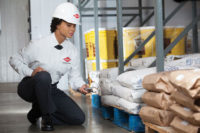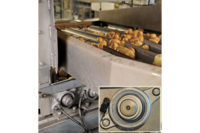A good cup ‘a Joe
Rotary batch mixers help a coffee bean processor achieve consistency in blends.
As coffee bar orders for triple-tall mocha lattes, double-shot cappuccinos, half-caf espressos and other coffee bar concoctions keep increasing, so does the demand for coffee beans. This is great news for companies like Papanicholas Coffee Co., a Midwestern processor of gourmet coffee beans.
Demand for the firm’s coffees, particularly its flavored blends, necessitated an expansion from the Midwest into select markets in the Northwest and Mid-Atlantic regions. As a result, the company moved into new facilities that house both corporate headquarters and a roasting plant with a capacity of more than a million pounds a year.
At the heart of the plant are a new 2,000-lb./hr. capacity Lilla roaster and two new Munson rotary batch mixers.
“There are many intricacies in the art of roasting coffee beans,” says Vaughn Papanicholas, vice president. “It takes tremendous experience to maintain consistency.” The Lilla roaster is designed to roast evenly and provide immediate cooling once the desired color and aroma are attained. With partial cooling in the drum itself and a cooling hopper to quickly drop the temperature of the roasted beans, the roaster protects the coffee’s aromatic oils for better flavor and appearance.
In Papanicholas’ new facility, each type of bean is roasted separately and then blended using a 50-cu.-ft. capacity stainless steel Munson rotary batch mixer. “The rotary mixer offers gentle tumbling action that does not break the beans or cause damage,” he says. This is a result of the low-rpm rotation of the mixing vessel, unlike stationary horizontal mixing vessels with rotating ribbon blades, plows or paddles that push through the material, increasing friction, degradation and heat build up.
Internal mixing flights of the rotary mixer alternate in direction for gravity-driven cascading of the material back and forth, producing a 100% uniform blend in three minutes or less. The flights also serve to direct the beans toward the discharge port, evacuating the vessel in three to four minutes with no residual in the machine.
The mixer has a stationary intake chute fed by a mechanical conveyor, and is fully enclosed, containing dust and preventing contamination of the product.
Papanicholas also purchased a 25-cu.-ft. Munson stainless steel rotary batch mixer for flavor spray coating downstream, replacing a continuous process coater from a different manufacturer. The rotary batch mixer is fully enclosed, a significant improvement, according to Papanicholas. The old machine was open on both ends, allowing the flavoring to mist out, so there was a substantial amount of waste. The enclosed design also prevents flavorings from wafting inside the building, invading the non-flavored area.
With a footprint of 7 ft. by 10 ft., the rotary batch mixer fits in the same space as the continuous mixer while tripling its output because of the short mixing time. The mixer can coat up to 6 batches per hour of a flavor, producing 2,600 lbs./hr. versus 900 lbs./hr. in the old machine. A CIP system eliminates manual cleaning, shortening downtime between flavors and further boosting production.u
For more information:
Charlie Divine; Munson Machinery Co.;
800-944-6644;
info@munsonmachinery.com
As coffee bar orders for triple-tall mocha lattes, double-shot cappuccinos, half-caf espressos and other coffee bar concoctions keep increasing, so does the demand for coffee beans. This is great news for companies like Papanicholas Coffee Co., a Midwestern processor of gourmet coffee beans.
Demand for the firm’s coffees, particularly its flavored blends, necessitated an expansion from the Midwest into select markets in the Northwest and Mid-Atlantic regions. As a result, the company moved into new facilities that house both corporate headquarters and a roasting plant with a capacity of more than a million pounds a year.
At the heart of the plant are a new 2,000-lb./hr. capacity Lilla roaster and two new Munson rotary batch mixers.
“There are many intricacies in the art of roasting coffee beans,” says Vaughn Papanicholas, vice president. “It takes tremendous experience to maintain consistency.” The Lilla roaster is designed to roast evenly and provide immediate cooling once the desired color and aroma are attained. With partial cooling in the drum itself and a cooling hopper to quickly drop the temperature of the roasted beans, the roaster protects the coffee’s aromatic oils for better flavor and appearance.
In Papanicholas’ new facility, each type of bean is roasted separately and then blended using a 50-cu.-ft. capacity stainless steel Munson rotary batch mixer. “The rotary mixer offers gentle tumbling action that does not break the beans or cause damage,” he says. This is a result of the low-rpm rotation of the mixing vessel, unlike stationary horizontal mixing vessels with rotating ribbon blades, plows or paddles that push through the material, increasing friction, degradation and heat build up.
Internal mixing flights of the rotary mixer alternate in direction for gravity-driven cascading of the material back and forth, producing a 100% uniform blend in three minutes or less. The flights also serve to direct the beans toward the discharge port, evacuating the vessel in three to four minutes with no residual in the machine.
The mixer has a stationary intake chute fed by a mechanical conveyor, and is fully enclosed, containing dust and preventing contamination of the product.
Papanicholas also purchased a 25-cu.-ft. Munson stainless steel rotary batch mixer for flavor spray coating downstream, replacing a continuous process coater from a different manufacturer. The rotary batch mixer is fully enclosed, a significant improvement, according to Papanicholas. The old machine was open on both ends, allowing the flavoring to mist out, so there was a substantial amount of waste. The enclosed design also prevents flavorings from wafting inside the building, invading the non-flavored area.
With a footprint of 7 ft. by 10 ft., the rotary batch mixer fits in the same space as the continuous mixer while tripling its output because of the short mixing time. The mixer can coat up to 6 batches per hour of a flavor, producing 2,600 lbs./hr. versus 900 lbs./hr. in the old machine. A CIP system eliminates manual cleaning, shortening downtime between flavors and further boosting production.u
For more information:
Charlie Divine; Munson Machinery Co.;
800-944-6644;
info@munsonmachinery.com
Looking for a reprint of this article?
From high-res PDFs to custom plaques, order your copy today!






